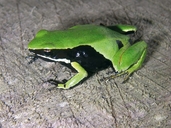|
Description
A small Mantella. Small specimens of slender appearance, large specimens rather stout, 17-24 mm (F 23-24 mm). Head, dorsum and posterior part of flanks yellow, orange or light green, sometimes (mainly in the yellowish specimens) with fine black spots. Sometimes an indistinct dark middorsal line and traces of a diamond marking. Head laterally, and anterior flanks generally black (black pattern can be largely reduced in some specimens), with a sharp dorsolateral colour border. Light frenal stripe present, often interrupted in the yellowish specimens. Bright red flashmarks present. Iris with some light pigment in its upper part. Ventrally black with a variable number and extension of grey to bluish-white or yellowish markings, sometimes fusing to form an irregular network. Horseshoe marking present and mostly distinct, but poorly expressed in some specimens. Hindlimbs sometimes uniformly orange or reddish ventrally, except the red ventral flashmark extension on the tibia. In other specimens, orange colour only present on tibia (except flashmark area); foot, tarsus and femur being black with grey-whitish markings.
Similar species: The colouration of typical M. crocea is unique, but other populations show all intermediates between M. crocea and M. milotympanum. A reliable distinction of these two forms is therefore not possible.
Excerpt with permission from Glaw and Vences (2007). Distribution and Habitat
Country distribution from AmphibiaWeb's database: Madagascar
Ambohimanarivo, Ambohitantely, Ampangadimbolana, Ihofa, north of Fierenana. It occurs between 800-1,057m asl in secondary forest and forest edge around swamps but not open areas (Raxworthy and Vences 2008).Life History, Abundance, Activity, and Special Behaviors
M. crocea is active during the day. The call consists of an irregular series of short chirping notes.
Breeding takes place in swamps where the larvae develop (Raxworthy and Vences 2008). Trends and Threats
Endangered: extent of occurrence is less than 5,000 km2 and its area of occupancy is probably less than 500km2, it is known from a single location, and the extent of its forest habitat in east-central Madagascar is declining, and the number of mature individuals might also be declining through over-exploitation.It has not been recorded from any protected areas, but is likely to occur in Parc National de Mantadia and the Réserve Naturelle Intégrale de Zahamena. A carefully regulated trade is required for this species (Raxworthy and Vences 2008). Possible reasons for amphibian decline General habitat alteration and loss
Habitat modification from deforestation, or logging related activities
Intensified agriculture or grazing
Urbanization
Habitat fragmentation
Comments
During surveys in the Ambohitantely Special Reserve, a surveyor experienced an adverse reaction following the handling of Mantella crocea. Side effects included tingling of the fingers, hands and lower arms, highly elevated heart rate and feeling faint. Side effects lasted approximately 20 minutes, and after one hour the surveyor returned to normal. First aid included washing the affected hands in the stream adjacent to the frog, and taking anti-histamine tablets. (pers. comm. Katherine Mullin, Cardiff University, UK)
References
Glaw, F., and Vences, M. (2007). Field Guide to the Amphibians and Reptiles of Madagascar. Third Edition. Vences and Glaw Verlag, Köln.
Raxworthy, C. and Vences, M. (2008). Mantella crocea. In: IUCN 2008. 2008 IUCN Red List of Threatened Species. . Downloaded on 22 April 2009.
Originally submitted by: Miguel Vences and Frank Glaw (first posted 2000-12-13)
Edited by: Henry Zhu, Michelle Koo (2020-06-11)Species Account Citation: AmphibiaWeb 2020 Mantella crocea <https://amphibiaweb.org/species/4564> University of California, Berkeley, CA, USA. Accessed May 29, 2025.
Feedback or comments about this page.
Citation: AmphibiaWeb. 2025. <https://amphibiaweb.org> University of California, Berkeley, CA, USA. Accessed 29 May 2025.
AmphibiaWeb's policy on data use.
|
